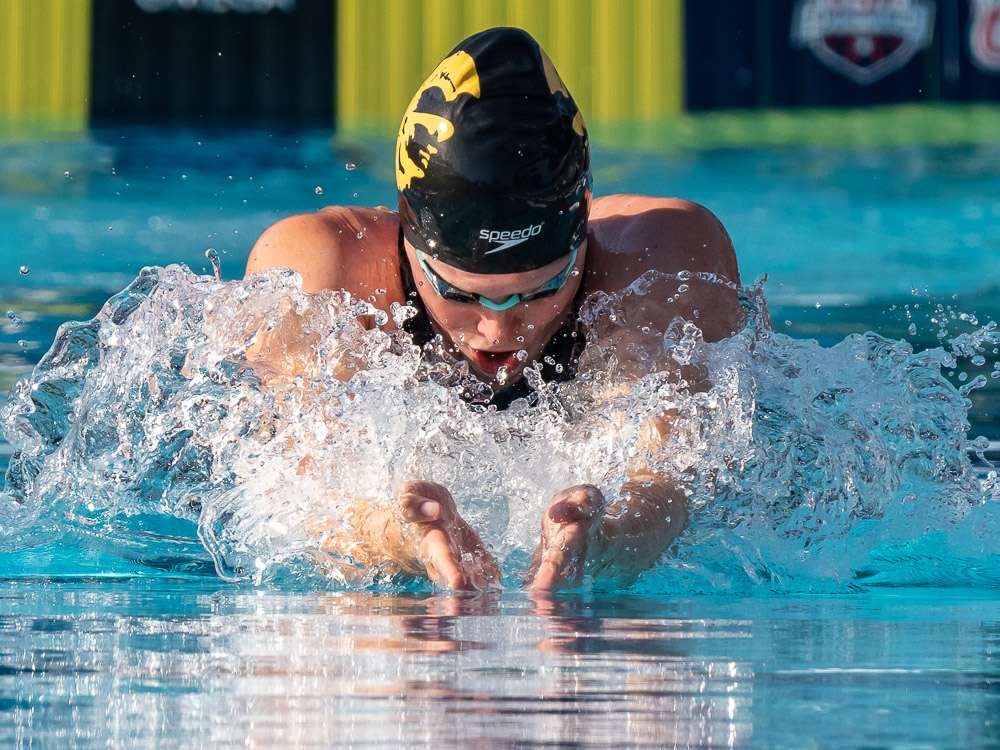Spotlighting the Women Who Have Achieved NCAA ‘A’ Cuts This Season

This season, a handful of swimmers have already achieved an “A” cut and are qualified for the NCAA Championships in March. In individual events, “A” cuts are calculated using the three-year average of the eighth-fastest time in each event. In relays, it’s the three-year average of the 16th-fastest time in each event. However, there is one exception to the calculation: if the current standard is faster than the three-year average, it will remain in place. This season, the NCAA will also take long-course times. Long-course qualification can count from the U.S. Open and from the Doha World Championships in February. However, all these swimmers on this list swam their “A” cuts in short-course yards.
Gretchen Walsh, Virginia
50 Freestyle (20.95); 100 Freestyle (46.42); 100 Backstroke (49.17); 100 Butterfly (49.11)
In one of the most incredible dual-meet performances ever, Walsh ripped four “A” cuts and nation-leading times. The most mind-boggling fact, however, is that Walsh did all this in a practice suit.
At last year’s NCAAs in the 50 freestyle, 100 backstroke, and 100 free, there were only three other swimmers, not named Gretchen Walsh, who swam faster than Walsh’s unsuited 50 free, 100 back, and 100 free from the Texas-Virginia dual meet: Maggie Mac Neil, Katharine Berkoff and Kate Douglass, and two of the three aren’t returning.
Outside of that, no one at the 2023 meet could even touch Walsh’s unsuited times from this season.
In the 100 fly, Walsh was a 49.11, which would have been good enough for fourth at last year’s NCAAs.
Walsh looks poised for her best season yet and some new NCAA records.
Katharine Berkoff, N.C. State
100 Backstroke (50.83)
Achieving “A” cuts isn’t anything new for Berkoff, and in action against ASU, Berkoff blasted a 50.83 in the 100 backstroke, just sliding under the 50.88 “A” cut. Berkoff was the 2021 and 2022 NCAA champion in the 100 back before getting second to Gretchen Walsh last season.
Berkoff will most likely need to cut at least half a second off her 100 backstroke PR of 48.74 to challenge for the title versus against Walsh. Regardless, an “A” cut this early in the season is fantastic.
Kaitlyn Dobler, USC
100 Breaststroke (57.35)
Dobler captured the 100 breaststroke title at the SMU Invitational to secure her “A” cut. Dobler has performed fast in the early months of a season before. Last November, she was a 56.94 at the Art Adamson Invitational.
Dobler will have her hands full come March, as the 100 breaststroke looks wide open, with names such as Lydia Jacoby, Anna Elendt, and Jasmine Nocentini in the picture. However, if Dobler is at her best, she’ll be the one to beat.
Emma Sticklen, Texas
100 Butterfly (50.48)
Sticklen, who was last year’s 200 butterfly national champion, posted a 50.48 100 fly at the Texas-Texas A&M-Georgia Tech meet to slide under the 50.69 “A” cut.
Sticklen’s 100 fly currently ranks second in the country, only behind Walsh’s 49.11. While the 100 fly isn’t her best event, she still is one the best in the county in the shorter distance. Sticklen will lead a strong Texas team, which finished second at last year’s NCAAs.
Relays
Virginia
200 Medley Relay (1:34.32); 400 Medley Relay (3:27.56); 200 Freestyle Relay (1:26.85); 400 Freestyle Relay (3:12.74)
Virginia is the team to beat again, and in relays, the Cavaliers are shining. Earlier this season, they posted four “A” cuts at the Virginia-Texas dual meet/superfinals.
Last year, Virginia went 5-for-5 at NCAAs, claiming every relay title. Despite roster losses like Kate Douglass and Lexi Cuomo, Virginia still dominates. Transfer Jasmine Nocentini looks to be an incredible get for the Virginia women. As a sprint freestyler and breaststroker, she is the perfect fit for the Cavalier women. At the Texas-Virginia meet, Nocentini was 58.19 in the 100 breaststroke, 47.82 in the 100 free, and led off the 200 free relay in 21.89.
Texas
200 Medley Relay (1:35.63); 200 Free Relay (1:27.07)
Texas has already captured two “A” cuts this year, one in the 200 medley relay and the other in the 200 free relay. The Longhorns’ 1:27.07 in the 200 free relay is faster than they swam at last year’s NCAAs.
The 200 free relay was arguably one of Texas’ weaker relays last year, as they finished sixth in that event. This year, it looks like they’ll be vastly improved in that event come March, which can only be a positive for the Longhorns.
USC
200 Medley Relay (1:35.37); 400 Medley Relay (3:28.33)
USC is off to a hot start this year, and in the medley relays, the Trojans have already have secured “A” cuts. USC returns three of five contributors from their pair of 10th-place medley relays at last year’s NCAAs. One of the most significant additions to the Trojan squad has been Vasilissa Buinaia. Buinaia split a 47.14 on the 400 medley this year and is a 22.08 flat start in the 50 freestyle.
USC also has a great deal of talent coming in that will help the team, such as Claire Tuggle and Hungarian freshman Minna Abraham. Don’t be surprised if USC challenges for the Pac-12 title.
Texas A&M
400 Medley Relay (3:30.31)
The best relay finish at last year’s NCAAs for the Aggies was 16th in the 400 medley relay (3:32.29). This season, the Aggies are nearly two seconds ahead of that performance. In the 400 medley relay, the Aggies return everyone from last season, but freshman Miranda Grana looks to have taken over the backstroke spot.
Grana has been an enormous boost for the Aggies and was 51.87 leading off the 400 medley. That 51.87 is the sixth-fastest 100 back in the country this season and could be the piece that gets some Aggie relays into top-five contention.



